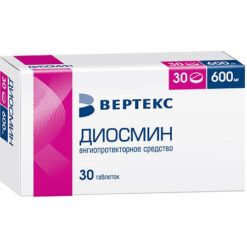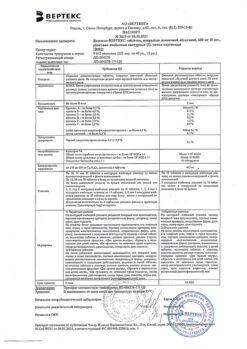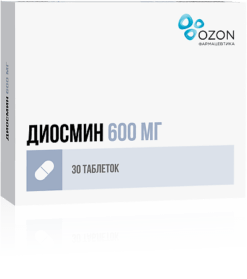No products in the cart.
Diosmin-Vertex, 600 mg 60 pcs
€28.04 €24.30
Description
Pharmacotherapeutic group
Angioprotective agent
ATCode
C05CA03
Pharmacodynamics:
Diosmin is a benzpyrone derivative. It belongs to the group of bioflavonoids. It has phlebotonic action (reduces vein stretching (dose-dependent effect) reduces venous congestion) improves lymphatic drainage (increases tone and frequency of contraction of the lymph capillaries increases their functional density reduces lymphatic Improves microcirculation (increases capillary resistance (dose-dependent effect) decreases their permeability) decreases leukocyte adhesion to the venous wall and their migration into paravenous tissue improves oxygen diffusion and perfusion in the skin tissue It has anti-inflammatory effect. It enhances the vasoconstrictor effect of adrenaline noradrenaline blocks the production of free radicals synthesis of prostaglandins and thromboxane. It was shown that diosmin decreases the content in plasma of the enzymes responsible for the metabolism of mucopolysaccharides in the venous wall.
In clinical trials diosmin decreased the capacity of the venous bed and the volume of venous stasis (according to plethysmography) decreased average pressure in deep and superficial leg veins (according to ultrasonic Dopplerography) and increased systolic and diastolic blood pressure in patients with postoperative orthostatic hypotension.
Pharmacokinetics:
Intake
It is rapidly absorbed from the gastrointestinal tract is detectable in plasma 2 hours after administration. Bioavailability of diosmin after oral administration is approximately 40-579%. In the intestine diosmin is transformed by intestinal microflora into diosmethine hippuric acid and benzoic acid.
Distribution
The maximum concentration in plasma is reached 5 hours after intake. Diosmin is evenly distributed and accumulates in all layers of the wall of the hollow veins and subcutaneous veins of the lower extremities to a lesser extent in the kidneys, lungs and other tissues. The volume of distribution is 621 liters. Selective accumulation of diosmin and/or its metabolites in the venous vessels reaches a maximum by the ninth hour after administration and persists for 96 hours.
Metabolism
Diosmin is metabolized in the liver. The main metabolite is hydroxyphenylpropionic acid. Metabolites of diosmin are excreted mainly by the kidneys in the form of conjugates with glucuronic acid.
79% of ingested diosmin is excreted by the kidneys through the intestine – 11% with the bile – 24%. Enterohepatic circulation of diosmin is noted. After intake of radioactive isotope-labeled diosmin, approximately 86% is excreted by the kidneys and intestines within 48 hours.
Indications
Indications
As part of complex therapy:
– to eliminate the symptoms of varicose veins of the lower extremities;
– to eliminate the symptoms of chronic lymphovenous insufficiency of the lower extremities: a feeling of heaviness or fatigue in the legs; pain;
– in case of microcirculation disorders;
– to eliminate the symptoms of acute hemorrhoids.
Pharmacological effect
Pharmacological effect
Pharmacotherapeutic group
Angioprotective agent
ATX code
C05CA03
Pharmacodynamics:
Diosmin is a benzpyrone derivative. Belongs to the group of bioflavonoids. Has a phlebotonic effect (reduces the distensibility of veins, increases the tone of the veins (dose-dependent effect), reduces venous stagnation) improves lymphatic drainage (increases the tone and frequency of contraction of lymphatic capillaries, increases their functional density, reduces lymphatic pressure) improves microcirculation (increases the resistance of capillaries (dose-dependent effect), reduces their permeability) reduces the adhesion of leukocytes to the venous wall and their migration into paravenous tissues improves the diffusion of oxygen and perfusion in the skin tissue has an anti-inflammatory effect. Enhances the vasoconstrictor effect of adrenaline, norepinephrine, and blocks the production of free radicals; the synthesis of prostaglandins and thromboxane. It has been shown that diosmin reduces the plasma levels of enzymes responsible for the metabolism of mucopolysaccharides in the venous wall.
In clinical studies, diosmin reduced venous capacity and venous stasis volume (as measured by plethysmography), decreased mean pressure in the deep and superficial veins of the legs (as measured by Doppler ultrasound), and increased systolic and diastolic blood pressure in patients with postoperative orthostatic hypotension.
Pharmacokinetics:
Suction
Rapidly absorbed from the gastrointestinal tract and found in the blood plasma 2 hours after administration. The bioavailability of diosmin after oral administration is approximately 40-579%. In the intestine, diosmin is transformed by intestinal microflora into diosmetin hippuric and benzoic acid.
Distribution
The maximum concentration in blood plasma is achieved 5 hours after administration. Diosmin is evenly distributed and accumulates in all layers of the wall of the vena cava and saphenous veins of the lower extremities, to a lesser extent in the kidneys of the liver, lungs and other tissues. The distribution volume is 621 l. Selective accumulation of diosmin and/or its metabolites in venous vessels reaches a maximum by the ninth hour after administration and persists for 96 hours.
Metabolism
Diosmin is metabolized in the liver. The main metabolite is hydroxyphenylpropionic acid. Diosmin metabolites are excreted primarily by the kidneys in the form of conjugates with glucuronic acid.
Removal
79% of taken diosmin is excreted by the kidneys through the intestines – 11% with bile – 24%. Enterohepatic circulation of diosmin is noted. After taking radiolabeled diosmin, approximately 86% is excreted by the kidneys and intestines within 48 hours.
Special instructions
Special instructions
Treatment of acute hemorrhoids is carried out in combination with other drugs. If there is no rapid clinical effect, it is necessary to conduct additional examination and adjust the therapy.
If venous circulation is impaired (varicose veins of the lower extremities, chronic lymphovenous insufficiency of the lower extremities), the maximum effect of treatment is ensured by a combination of therapy with lifestyle changes: it is advisable to avoid prolonged stay in an upright position to reduce excess body weight. In some cases, wearing special stockings (compression stockings) helps improve blood circulation.
If there is no improvement or if the symptoms of the disease worsen, consult a doctor.
Do not exceed the maximum duration and recommended doses of the drug without consulting a doctor.
Impact on the ability to drive vehicles. Wed and fur.:
There is no data on the negative effect of the drug on the ability to drive vehicles and other mechanisms.
Active ingredient
Active ingredient
Diosmin
Composition
Composition
One film-coated tablet contains:
active ingredient: diosmin – 600.00 mg;
excipients: microcrystalline cellulose – 241.50 mg; talc – 18.00 mg; hyprolose (hydroxypropylcellulose) – 13.50 mg; croscarmellose sodium – 13.50 mg; magnesium stearate – 9.00 mg; colloidal hydrophobic silicon dioxide – 4.50 mg; film coating: [hypromellose – 16.20 mg, talc – 5.40 mg, titanium dioxide – 2.79 mg, macrogol 4000 (polyethylene glycol 4000) – 2.43 mg, red iron oxide dye (iron oxide) – 0.18 mg] or [dry film coating mixture containing hypromellose (60%), talc (20%), titanium dioxide (10.33%), macrogol 4000 (polyethylene glycol 4000) (9%), red iron oxide dye (iron oxide) (0.67%)] – 27.00 mg.
Pregnancy
Pregnancy
Pregnancy
So far, in clinical practice there have been no reports of any side effects when using the drug in pregnant women. However, for safety reasons, it is not recommended to use the drug in the first trimester of pregnancy. Use during pregnancy in the second and third trimesters is possible only as prescribed by a doctor in cases where the expected benefit to the mother outweighs the potential risk to the fetus.
Experimental studies have not revealed a teratogenic effect of diosmin on the fetus.
Breastfeeding period
It is not recommended to take the drug during breastfeeding since there is no data on the penetration of diosmin into breast milk.
Contraindications
Contraindications
– Hypersensitivity to the components of the drug;
– 1st trimester of pregnancy and breastfeeding period (experience of use is limited);
– age up to 18 years.
Side Effects
Side Effects
Classification of the incidence of side effects according to the recommendations of the World Health Organization (WHO):
very often ≥ 1/10;
often from ≥ 1/100 to < 1/10;
infrequently from ≥ 1/1000 to < 1/100;
rarely from ≥ 1/10000 to < 1/1000;
very rare <1/10000 including isolated reports;
frequency unknown – based on available data, it is not possible to determine the frequency of occurrence.
From the gastrointestinal tract:
often – nausea, vomiting, diarrhea, dyspeptic disorders, heartburn, constipation; infrequently – colitis.
From the central nervous system:
rarely – headache, malaise, dizziness.
For the skin and subcutaneous fat:
rarely – skin rashes, itching.
Allergic reactions:
rarely – urticaria;
frequency unknown – isolated swelling of the face, lips, eyelids; in exceptional cases – angioedema (Quincke’s edema).
If any of the side effects indicated in the instructions get worse or you notice any other side effects not listed in the instructions, tell your doctor.
Interaction
Interaction
Clinically significant effects of interaction of diosmin with other drugs have not been described.
Overdose
Overdose
Symptoms
Overdose symptoms are not described. Given the wide therapeutic range of diosmin, the risk of intoxication in case of overdose appears to be insignificant.
Treatment
A specific antidote is unknown.
Storage conditions
Storage conditions
Store in a place protected from light at a temperature not exceeding 25 °C. Keep out of the reach of children.
Shelf life
Shelf life
3 years.
Do not use after expiration date.
Manufacturer
Manufacturer
Vertex, Russia
Additional information
| Shelf life | 3 years. Do not use after the expiration date. |
|---|---|
| Conditions of storage | Store in a light-protected place at a temperature not exceeding 25 °С. Keep out of reach of children. |
| Manufacturer | Vertex, Russia |
| Medication form | pills |
| Brand | Vertex |
Other forms…
Related products
Buy Diosmin-Vertex, 600 mg 60 pcs with delivery to USA, UK, Europe and over 120 other countries.


















